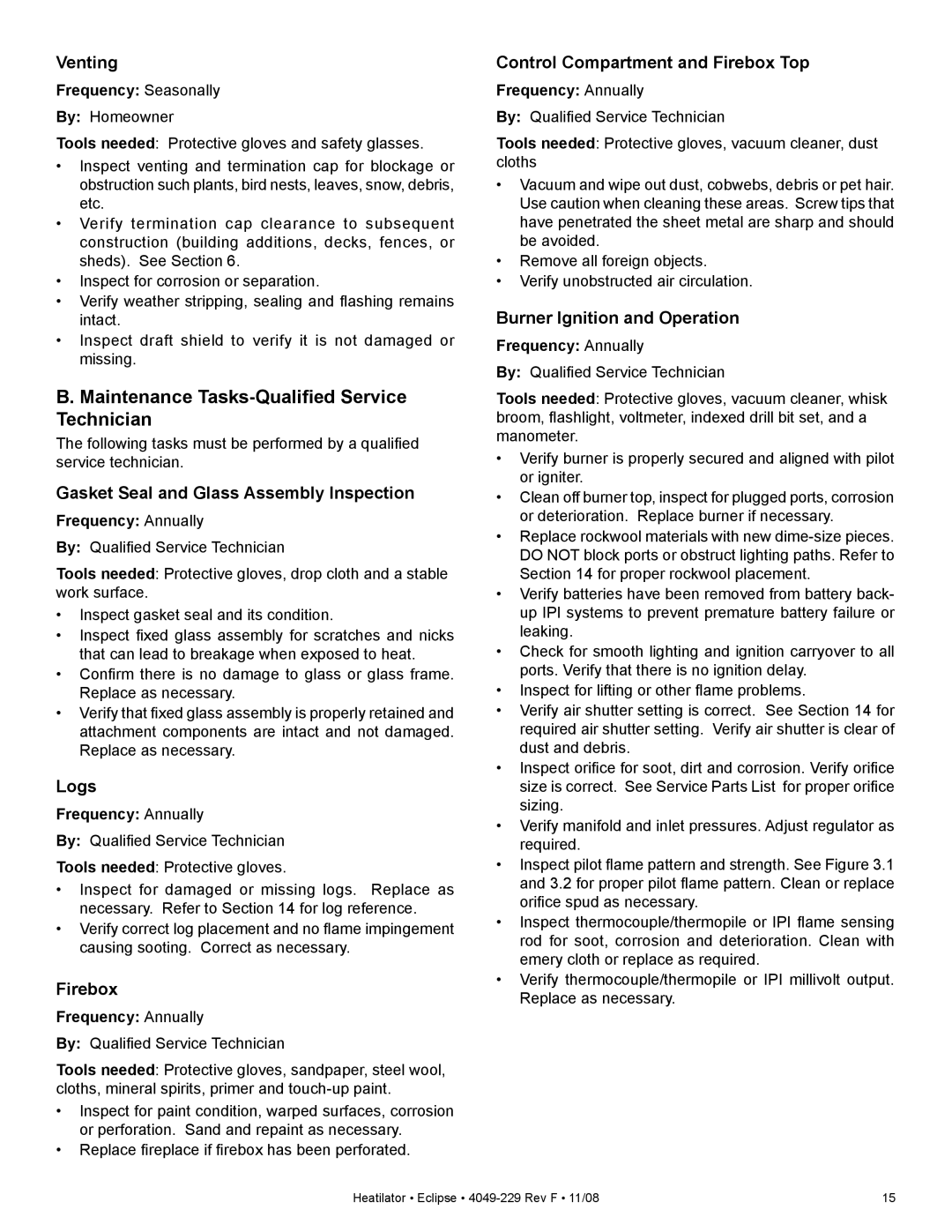Venting
Frequency: Seasonally
By: Homeowner
Tools needed: Protective gloves and safety glasses.
•Inspect venting and termination cap for blockage or obstruction such plants, bird nests, leaves, snow, debris, etc.
•Verify termination cap clearance to subsequent construction (building additions, decks, fences, or sheds). See Section 6.
•Inspect for corrosion or separation.
•Verify weather stripping, sealing and flashing remains intact.
•Inspect draft shield to verify it is not damaged or missing.
B. Maintenance Tasks-Qualified Service Technician
The following tasks must be performed by a qualified service technician.
Gasket Seal and Glass Assembly Inspection
Frequency: Annually
By: Qualified Service Technician
Tools needed: Protective gloves, drop cloth and a stable work surface.
•Inspect gasket seal and its condition.
•Inspect fixed glass assembly for scratches and nicks that can lead to breakage when exposed to heat.
•Confirm there is no damage to glass or glass frame. Replace as necessary.
•Verify that fixed glass assembly is properly retained and attachment components are intact and not damaged. Replace as necessary.
Logs
Frequency: Annually
By: Qualified Service Technician
Tools needed: Protective gloves.
•Inspect for damaged or missing logs. Replace as necessary. Refer to Section 14 for log reference.
•Verify correct log placement and no flame impingement causing sooting. Correct as necessary.
Firebox
Frequency: Annually
By: Qualified Service Technician
Tools needed: Protective gloves, sandpaper, steel wool, cloths, mineral spirits, primer and
•Inspect for paint condition, warped surfaces, corrosion or perforation. Sand and repaint as necessary.
•Replace fireplace if firebox has been perforated.
Control Compartment and Firebox Top
Frequency: Annually
By: Qualified Service Technician
Tools needed: Protective gloves, vacuum cleaner, dust cloths
•Vacuum and wipe out dust, cobwebs, debris or pet hair. Use caution when cleaning these areas. Screw tips that have penetrated the sheet metal are sharp and should be avoided.
•Remove all foreign objects.
•Verify unobstructed air circulation.
Burner Ignition and Operation
Frequency: Annually
By: Qualified Service Technician
Tools needed: Protective gloves, vacuum cleaner, whisk broom, flashlight, voltmeter, indexed drill bit set, and a manometer.
•Verify burner is properly secured and aligned with pilot or igniter.
•Clean off burner top, inspect for plugged ports, corrosion or deterioration. Replace burner if necessary.
•Replace rockwool materials with new
•Verify batteries have been removed from battery back- up IPI systems to prevent premature battery failure or leaking.
•Check for smooth lighting and ignition carryover to all ports. Verify that there is no ignition delay.
•Inspect for lifting or other flame problems.
•Verify air shutter setting is correct. See Section 14 for required air shutter setting. Verify air shutter is clear of dust and debris.
•Inspect orifice for soot, dirt and corrosion. Verify orifice size is correct. See Service Parts List for proper orifice sizing.
•Verify manifold and inlet pressures. Adjust regulator as required.
•Inspect pilot flame pattern and strength. See Figure 3.1 and 3.2 for proper pilot flame pattern. Clean or replace orifice spud as necessary.
•Inspect thermocouple/thermopile or IPI flame sensing rod for soot, corrosion and deterioration. Clean with emery cloth or replace as required.
•Verify thermocouple/thermopile or IPI millivolt output. Replace as necessary.
Heatilator • Eclipse • | 15 |
